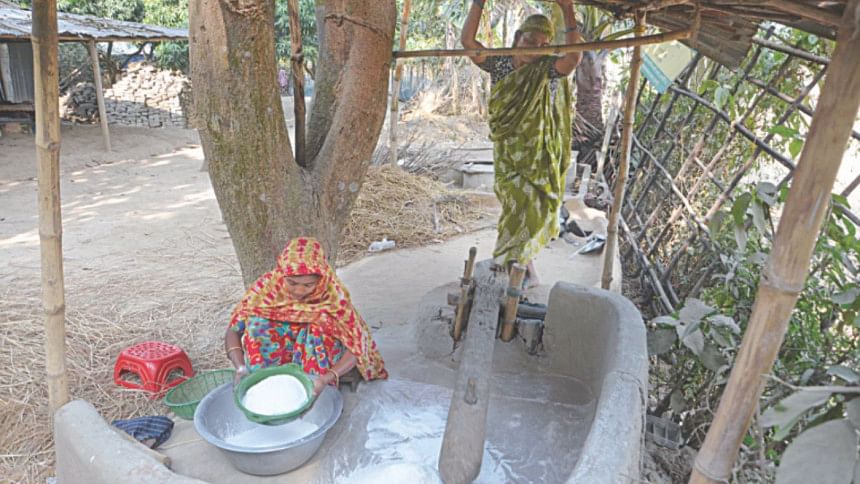Dheki lives on to make pitha tasty

Remember “dheki chhata chal”?
The rice finely threshed in a “dheki”, a heavy wooden pestle that was once popular among rural women in Bangladesh, has made a comeback to give the “puli pitha” (rice cakes) its unique taste for the inhabitants of a village in Rajshahi.
This was possible thanks to one Kobuljan Begum.
About 250 families of Horidebpur village in Tanore upazila use the 20-year-old dheki built and owned by Kobuljan, a housewife, to get the one of a kind “dheki chhata chal”.
Dheki, with its heavy wooden lever supported on a pedestal, has reinstated its place in Bengali proverbs, essays, and of course, folk songs.
In the 18th century, it was the lone tool to prepare Bengali meals. Bankim Chandra Chatterjee, in his collection of satirical essays -- Kamalakanta, wrote, “I wonder what I could eat if there was no dheki on Earth!”
Dheki gave birth to the famous Bengali proverb: “Dheki shorge geleo dhan bhane (Dekhi threshes paddy even if it lands in heaven)” meaning “habits hardly change!”
As they raised the lever of the dheki with their feet, women sang along to the rhythmic sounds -- “dhik-it-dhik” -- and thus songs like “O dhan bhanire dhekite par diya, dheki nache ami nachi helia dulia” were born.
At a time when “shortcuts” are seeping into all spheres of human lives, dheki seemed to be on the verge of being eroded from memories.
Yet, it lives on for the villagers of Horidebpur and it is bringing back the lost taste in hearty meals and winter delicacies.
Kobuljan built the dheki two decades ago because she did not like the taste of rice that comes from the mills.
“After the Boro harvest, we separate a portion of the paddy that we thresh using the dheki to make flour for making puli pitha in winter,” Kobuljan told this paper. “Rice threshed in modern mills does not have the same taste as the one threshed in dheki. I built it for the good taste in my meals.”
The agricultural tool is used to separate rice grains from their outer husks, to make flour and grind spices mainly, according to Kobuljan. “During winter, the dheki is a must for making flour. Otherwise, puli pitha lacks its authentic taste,” she continued.
Kobuljan initially kept the dheki inside her home but as a constant flow of visitors began, she later placed it on her courtyard for everyone to use.
However, she does not charge people for using her dheki. “I repair it from time to time, but I don't charge anything. I want to share the joy of tasting quality food with others,” she said.
She went on to say that threshing using a dheki was an art and not everyone's cup of tea.
One Sufia Begum and her daughter-in-law Parveen Begum were threshing 10 kilogram of rice in the dheki when this correspondent visited Kobuljan's house.
“We are threshing rice to make flour for pitha,” said Sufia. “We come to thresh spices during festivals.
“Pitha is baked well when we use dheki chhata chal. If we want tasty pithas, there is no better option than this,” she added.

 For all latest news, follow The Daily Star's Google News channel.
For all latest news, follow The Daily Star's Google News channel. 




Comments